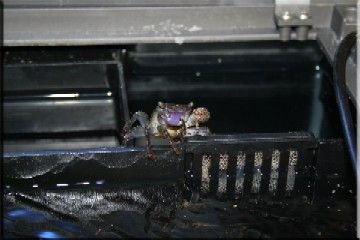Right, the bloody aptaisia has been given it's marching orders - Good old BigC has come up trumps and I have purchased a Aeolidiella stephanieae nudibranch

So, when he has eaten his way through my tank (the Nudibranch not BigC

) I will be looking to pass him on to someone with the same problem (don't want him to starve to death

), let me know if you would be interested

not sure how long he will take to finish the stuff off so can't promise a time scale.
Info from: Berghianet
Natural Aiptasia control is the goal of most reef keepers. Thousands of reef hobbyists and professionals now know that the Aiptasia removed by Berghia nudibranchs do not leave remnants from the foot of the Aiptasia behind to grow back later. Biologists and advanced reef keepers now recognize our Berghia nudibranchs are the only method of Aiptasia control or removal that consume the Aiptasia's Planula Larva preventing them from being released into the water column. Aiptasia species anemones are imported from around the world on maricultured coral plugs and live rocks as well as traded between tanks on macro algaes and at frag swaps. Aiptasia are also easily obtained from aquacultured corals that are grown in facilities that have not started using Berghia for Aiptasia control. Berghia are the only absolute natural Aiptasia control that can get down under, in holes and cracks and specifically remove the Aiptasia anemones including all of Berghia Verrucicornis Nudibranch Eating Aiptasia Anemone.
Originally widely published in journals and reef trade articles as one species, history reveals that several different species have been combined as if they were all one species. The nudibranch that exclusively feeds on Aiptasia anemones received it's own distinct taxonomical record in 2005. As of that date, the common name for the aquarium industry will remain "Berghia" and the correct scientific name is Aeolidiella stephanieae for this species.
the pedal lacerates and tiny Aiptasia that are the result of spawning in the reef. There is no fish or shrimp that can get all those tiny Aiptasia beginnings. Berghia may be combined with an Aiptasia eating fish to naturally control Aiptasia but the nudibranch is effective without any help when given the time. If a fish is used, the fish will keep some of the anemones that can be seen from growing on the top side of rocks and the Berghia nudibranch will remove the rest of the Aiptasia from the top, between coral colonies and from down under. It is the down under part we don't see that is the most important for a complete and final solution. It is possible to control Aiptasia species anemones such as Aiptasia mutabilis, Aiptasia pallida [Dysactis pallida], Aiptasia pulchella, Aiptasia californica with the Berghia nudibranch (occassionally misspelled as Bergia, a plant taxonomy) also known as Aeolidiella stephanieae. .
Seffie x





 my fish is bigger than your fish
my fish is bigger than your fish 
 She is doing really well, Thank you Seffie for the pods, my delivery didn't arrive over the christmas period and seffie came to the rescue with a pot of pods
She is doing really well, Thank you Seffie for the pods, my delivery didn't arrive over the christmas period and seffie came to the rescue with a pot of pods 




 and make a day of it
and make a day of it 

 Milly Molly Mandy is eating frozen, just saw her gulp some down
Milly Molly Mandy is eating frozen, just saw her gulp some down